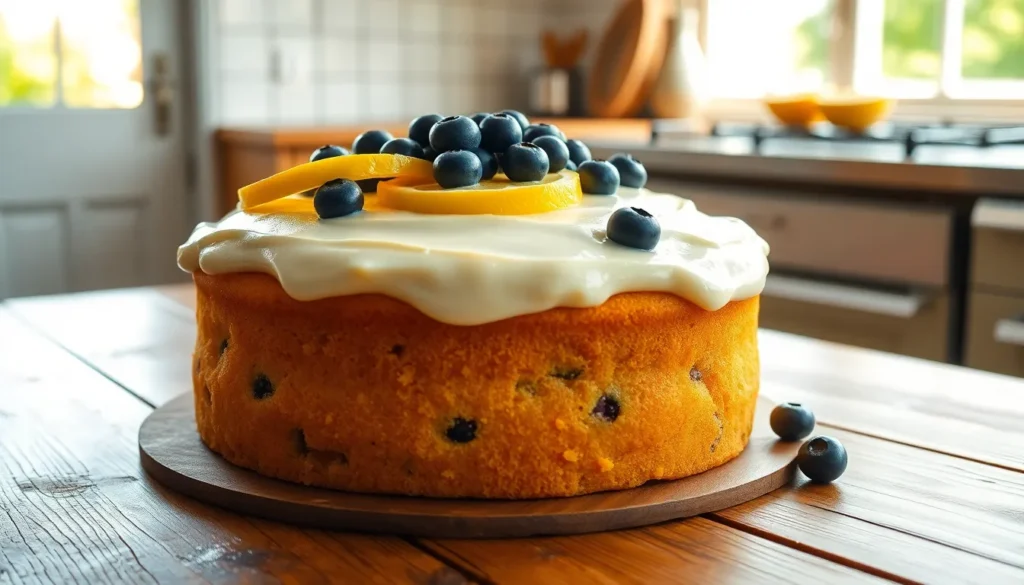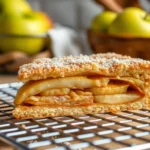Nothing beats the perfect harmony of bright citrus and sweet berries quite like our lemon blueberry cake. This stunning dessert combines the tangy zest of fresh lemons with juicy bursts of blueberries in every bite. We’ve perfected this recipe to deliver a moist tender crumb that’ll have your family asking for seconds.
The beauty of this cake lies in its versatility – it’s equally at home on a Sunday brunch table or dressed up for special celebrations. Fresh blueberries suspended throughout the batter create gorgeous pockets of flavor while lemon zest brightens the entire cake with its aromatic oils.
What makes our version special is the foolproof technique that prevents blueberries from sinking to the bottom. You’ll get perfectly distributed fruit in every slice plus that irresistible golden exterior that makes this cake as beautiful as it tastes.
Ingredients
We’ve organized our ingredient list into three sections to make your shopping and preparation seamless. Each component plays a crucial role in creating the perfect balance of citrus brightness and berry sweetness.
For the Cake
- 2½ cups all-purpose flour
- 2 teaspoons baking powder
- ½ teaspoon salt
- ½ cup unsalted butter, softened to room temperature
- 1¾ cups granulated sugar
- 4 large eggs, at room temperature
- 2 teaspoons vanilla extract
- Zest of 2 large lemons
- ⅓ cup fresh lemon juice
- 1 cup whole milk, at room temperature
- 1½ cups fresh blueberries, washed and dried
- 2 tablespoons all-purpose flour for coating blueberries
For the Lemon Glaze
- 1½ cups powdered sugar, sifted
- 3 tablespoons fresh lemon juice
- 1 tablespoon lemon zest
- 2 tablespoons whole milk
- Pinch of salt
For the Blueberry Topping
- ½ cup fresh blueberries, washed and dried
- 1 tablespoon granulated sugar
- 1 teaspoon lemon zest
Equipment Needed
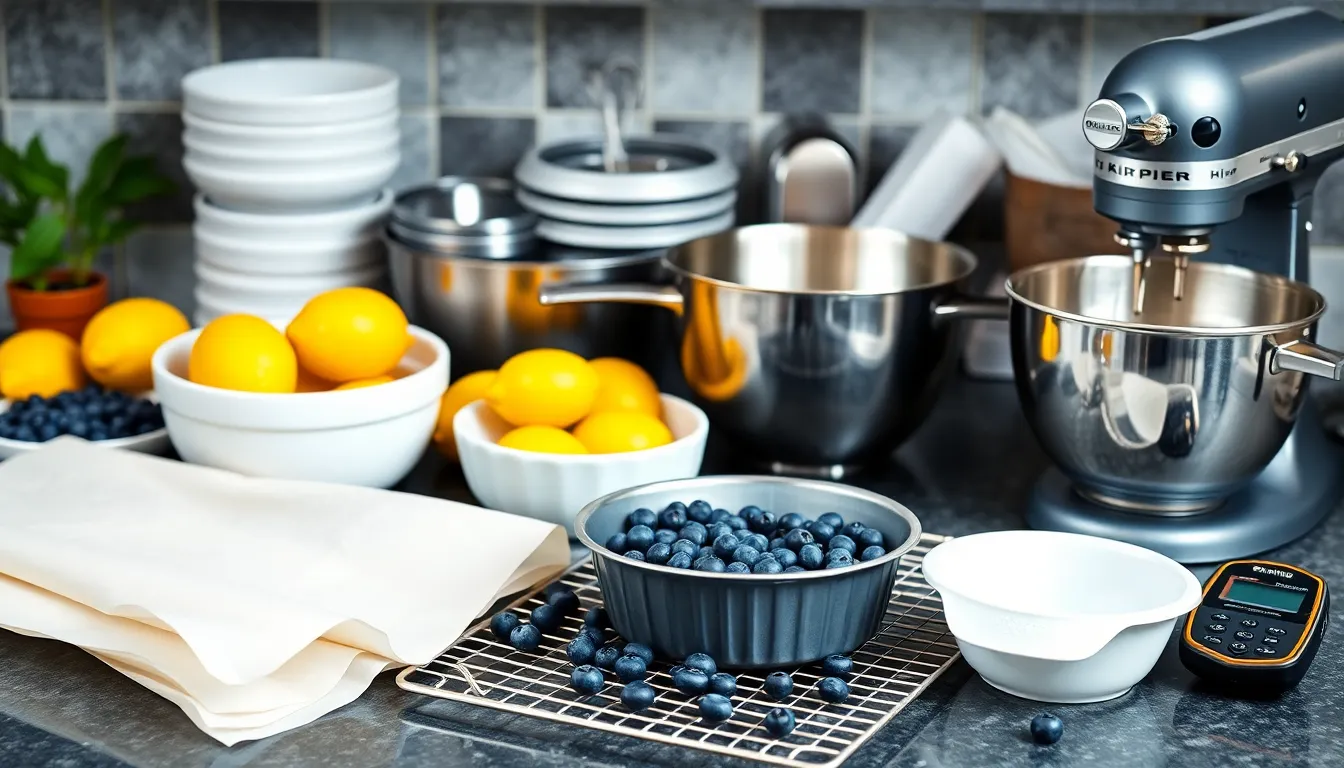
We’ll need several essential tools to create our perfect lemon blueberry cake with its signature moist texture and evenly distributed berries.
Mixing bowls and whisks form the foundation of our baking setup. Large mixing bowls allow us to combine dry and wet ingredients properly while a sturdy whisk helps us fold in those precious blueberries without crushing them.
Stand mixer or hand mixer becomes crucial for achieving the light and fluffy texture we want. These mixers cream our butter and sugar efficiently and create the smooth batter that gives our cake its tender crumb.
Measuring cups and spoons ensure our ingredient proportions remain accurate every time. Precise measurements make the difference between a good cake and an exceptional one.
Cake pans offer us flexibility in presentation. We can use two 8-inch round cake pans for elegant layers or choose a large Bundt pan for a stunning single cake that serves a crowd.
Parchment paper prevents our beautiful cake from sticking to the pan. This simple step saves us from heartbreak when we turn out our finished creation.
Wire cooling rack allows proper air circulation around our cake. Even cooling prevents condensation and maintains that perfect texture we worked so hard to achieve.
Oven preheated to 350°F provides the consistent heat our cake needs. This standard temperature ensures even baking throughout while developing that gorgeous golden exterior.
Each piece of equipment serves a exact purpose in creating our lemon blueberry masterpiece. Having everything ready before we start mixing makes the entire process smooth and enjoyable.
Prep Instructions
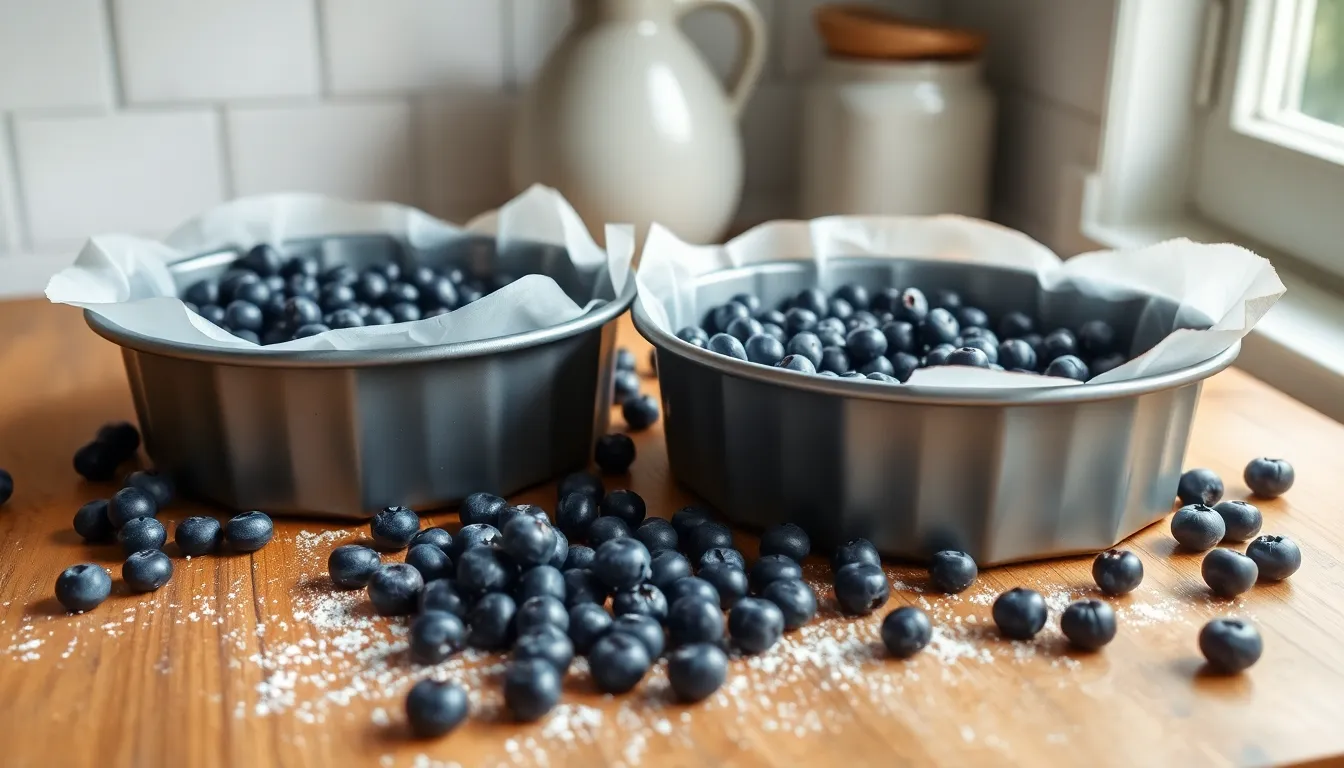
We need to complete a few essential preparation steps before mixing our lemon blueberry cake batter. These foundational tasks ensure our cake bakes evenly and maintains its beautiful appearance.
Preparing the Pan
First, we preheat our oven to 350°F (180°C) for conventional baking. Convection ovens require a slight temperature adjustment, so we reduce the heat by about 25 degrees if using that setting.
Next, we grease two 8-inch cake pans thoroughly with butter or cooking spray. We line the bottoms with parchment paper to prevent sticking and guarantee easy removal after baking. This step proves crucial for maintaining our cake layers’ integrity when we transfer them from the pans.
Preparing the Blueberries
We start by measuring out our fresh blueberries and placing them in a small bowl. Then we lightly coat the blueberries with one tablespoon of flour, tossing them gently until each berry has a thin dusting.
This flour coating serves a vital purpose in our baking process. The flour prevents the berries from sinking to the bottom during baking, ensuring even distribution throughout our finished cake layers. We set these prepared blueberries aside until we’re ready to fold them into our completed batter.
Directions
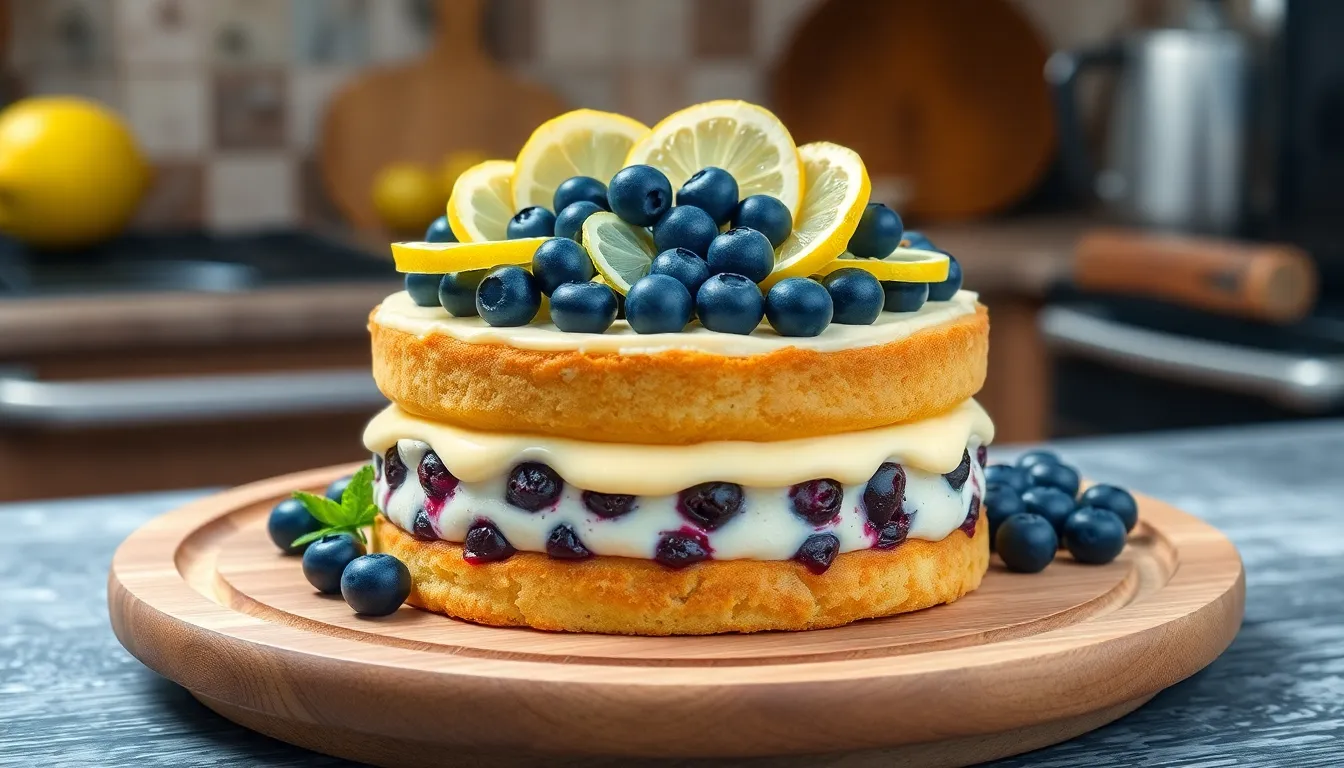
Now we’ll guide you through each step to create this delectable lemon blueberry cake. Follow our detailed instructions to achieve the perfect balance of flavors and textures.
Making the Cake Batter
Begin by combining the softened butter, granulated sugar, and lemon zest in a large mixing bowl. We cream these ingredients together for about 3 minutes until the mixture becomes light and fluffy. Add the eggs one at a time, mixing well after each addition to ensure proper incorporation.
In a separate bowl, we whisk together the flour, baking powder, baking soda, salt, and cornstarch. Gradually add these dry ingredients to our wet mixture, alternating with the milk and lemon juice. Mix until just combined, being careful not to overmix the batter.
Take your flour-coated blueberries and gently fold them into the batter using a rubber spatula. This coating technique prevents the berries from sinking to the bottom during baking and ensures even distribution throughout both layers.
Baking the Cake
Preheat your oven to 350°F (180°C) while you prepare the final batter. Divide the mixture evenly between your two prepared 8-inch cake pans, smoothing the tops with an offset spatula.
Bake for 35 to 40 minutes, or until a toothpick inserted in the center comes out clean. The tops should be golden brown and spring back when lightly touched. Allow the cake layers to cool in their pans for 20 minutes before transferring them to wire racks to cool completely.
Preparing the Lemon Glaze
While the cakes cool, we prepare our bright lemon glaze. Whisk together the powdered sugar and fresh lemon juice in a medium bowl until the mixture reaches a smooth consistency. Add lemon zest for extra citrus flavor and a pinch of salt to enhance the overall taste.
Adjust the glaze consistency by adding more powdered sugar for thickness or more lemon juice for a thinner drizzle. The glaze should coat the back of a spoon but still flow easily when poured.
Assembly and Finishing
Once our cake layers have cooled completely, we place the first layer on a serving plate. Spread a generous amount of lemon glaze evenly across the top surface, allowing some to drip down the sides.
Carefully place the second cake layer on top and cover the entire cake with the remaining glaze. Work quickly but gently to maintain the cake’s delicate structure. Garnish with fresh blueberries and thin lemon slices for an elegant presentation that showcases the cake’s beautiful flavors.
Storage Instructions
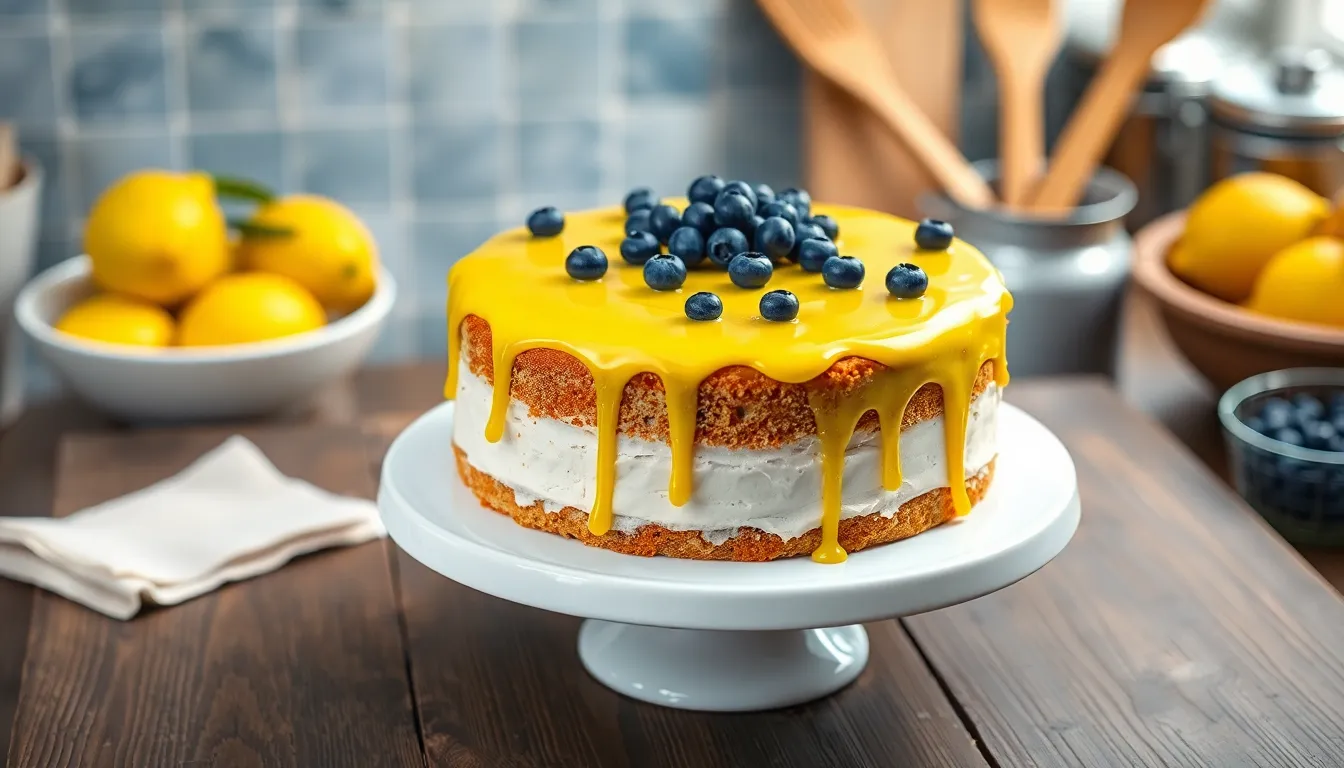
After creating this delicious lemon blueberry cake, we want to ensure it stays fresh and maintains its wonderful flavor for as long as possible. The storage method we choose depends on our frosting type and how long we plan to keep the cake.
Room Temperature Storage
We can store our lemon blueberry cake at room temperature for up to two days when it doesn’t contain cream cheese frosting. This method works perfectly for cakes with our lemon glaze since it doesn’t require refrigeration. We should place the cake in an airtight container or cover it tightly with plastic wrap to prevent it from drying out.
| Storage Method | Duration | Best For |
|---|---|---|
| Room Temperature | Up to 2 days | Cakes without cream cheese frosting |
| Refrigeration | Up to 1 week | All cake types, especially with dairy frosting |
| Freezing (layers) | Up to 2 months | Unfrosted cake layers |
| Freezing (slices) | Up to 2 months | Individual portions |
Refrigeration Guidelines
We recommend refrigerating our lemon blueberry cake when it contains cream cheese frosting or other dairy-based toppings. The refrigerator keeps the cake fresh for up to one week when stored in an airtight container. This method prevents spoilage and maintains the cake’s moisture while protecting any dairy components from bacterial growth.
Freezing Options
We have two excellent freezing options for our lemon blueberry cake. First, we can wrap unfrosted cake layers individually in plastic wrap and freeze them for up to two months. Once we’re ready to serve, we simply thaw the layers at room temperature before adding our glaze and toppings. Alternatively, we can freeze individual slices for up to two months, which creates convenient single-serving portions perfect for future treats.
Blueberry Handling Tips
Our blueberry preparation technique significantly impacts the cake’s final appearance and storage quality. We coat fresh blueberries with 1 to 2 tablespoons of flour before folding them into our batter to prevent sinking during baking. When using frozen blueberries, we can add them directly to the batter without thawing, though this may require slightly longer baking time to ensure the cake cooks through completely.
Make-Ahead Tips

Planning ahead transforms your lemon blueberry cake baking experience from stressful to seamless. We recommend baking the cake layers up to two days in advance and storing them at room temperature for optimal results.
Storing Unfrosted Cake Layers
Wrap each cooled cake layer tightly in plastic wrap or food wrap immediately after cooling. This method maintains moisture and prevents the cake from drying out during storage. Room temperature storage works perfectly for up to two days when the cake remains unfrosted.
Freezing for Extended Storage
Unfrosted cake layers freeze beautifully for up to one month when properly wrapped. We suggest wrapping each layer individually in plastic wrap before placing them in an airtight container. Thaw frozen layers at room temperature before assembly and frosting.
Refrigeration Guidelines
Keep frosted cakes with cream cheese buttercream in the refrigerator overnight due to the dairy content. Unfrosted layers can remain at room temperature until you’re ready to frost and serve.
Assembly Day Strategy
Chill or freeze assembled cake layers for about 60 minutes before final frosting. This technique firms up the cake structure and makes handling much easier during the decorating process. The firmer texture prevents breakage and creates cleaner frosting lines.
Timing Your Preparation
| Task | Timing | Storage Method |
|---|---|---|
| Bake cake layers | 1-2 days ahead | Room temperature, wrapped |
| Prepare frosting | 1 day ahead | Refrigerated separately |
| Final assembly | Day of serving | Assemble fresh for best results |
Prepare your lemon glaze and blueberry topping components separately one day in advance. Store the glaze at room temperature and keep fresh blueberry garnishes refrigerated until assembly time. This approach ensures each component maintains its optimal texture and flavor profile when combined.
Serving Suggestions

We recommend serving this lemon blueberry cake at room temperature to achieve optimal texture and allow the bright flavors to shine through. The cake’s moist crumb and vibrant citrus notes are best experienced when it has had time to come to proper serving temperature after refrigeration.
For elegant presentation, we slice the cake using a sharp knife wiped clean between cuts to maintain neat edges. Each slice benefits from a generous dollop of cream cheese buttercream frosting, which provides a tangy contrast to the sweet cake layers. The frosting’s smooth texture complements the tender crumb while improving the overall flavor profile.
We find this cake pairs beautifully with a variety of accompaniments that enhance its natural flavors. A light dusting of powdered sugar creates an attractive finish while adding subtle sweetness. Fresh whipped cream offers a delicate contrast to the cake’s dense texture, while a scoop of vanilla ice cream transforms each serving into an indulgent dessert experience.
A drizzle of additional lemon glaze elevates the citrus notes and creates visual appeal on the plate. We often garnish individual slices with fresh blueberries and thin lemon wheel slices to echo the cake’s key ingredients. These finishing touches not only enhance presentation but also provide bursts of fresh flavor with each bite.
This versatile dessert shines across multiple occasions and settings. We serve it at brunches where its bright flavors complement morning beverages and lighter fare. Afternoon tea gatherings benefit from the cake’s refined presentation and balanced sweetness. The dessert works equally well at casual family dinners and special celebrations where its impressive appearance makes a memorable finale to any meal.
The cake’s sturdy structure makes it ideal for outdoor gatherings and potluck events where transport and serving ease matter. We appreciate how individual slices hold their shape well while maintaining the perfect balance of tender cake, juicy blueberries, and zesty lemon throughout each portion.
Recipe Variations
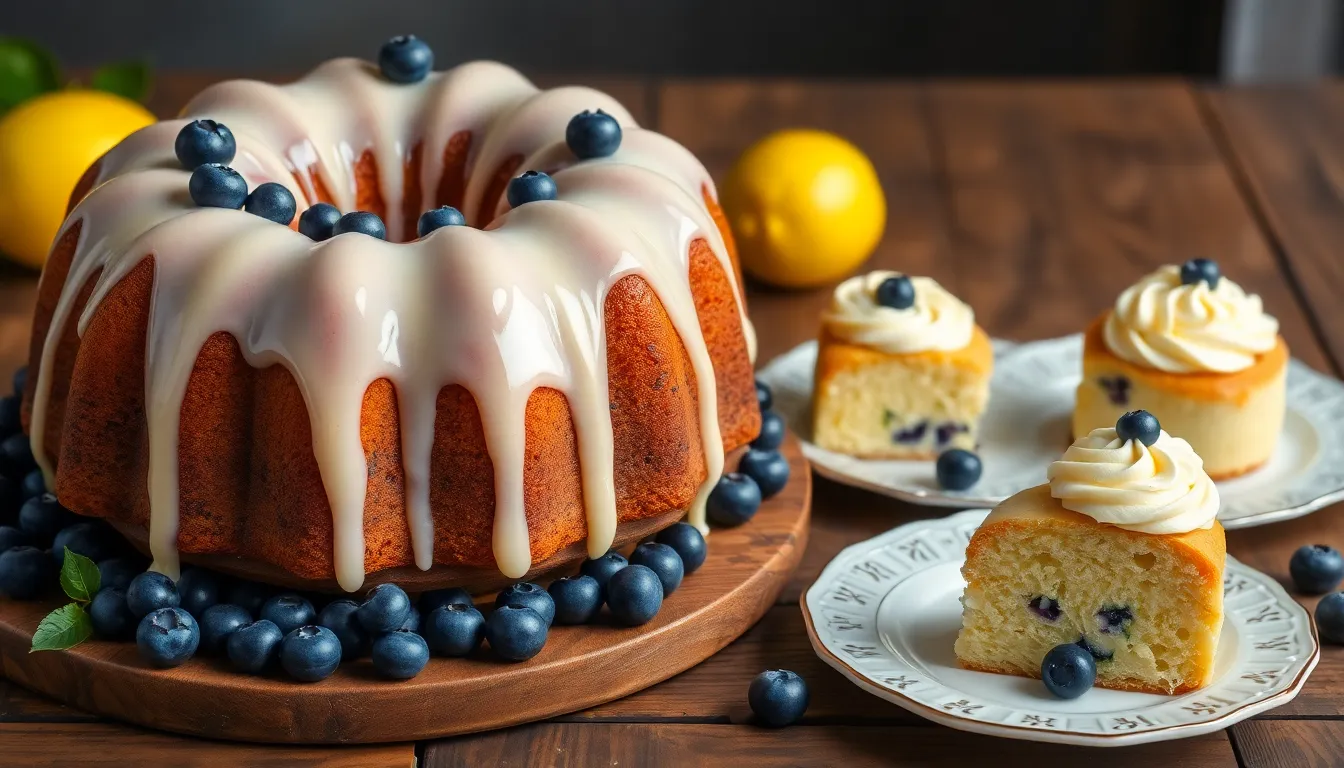
We love how adaptable this lemon blueberry cake recipe is for different occasions and preferences. These variations offer exciting ways to present the same beloved flavors in fresh formats.
Lemon Blueberry Bundt Cake
We recommend the Bundt cake variation for family gatherings and brunches where you want impressive presentation with minimal effort. This single-layered ring-shaped format bakes beautifully in a standard Bundt pan and eliminates the need for layer stacking or complex assembly.
Our Bundt version uses the same base recipe but requires slight adjustments to baking time and temperature. We extend the baking time to 50-60 minutes at 350°F to ensure the thicker batter cooks through completely. The signature ring shape creates natural drainage that prevents soggy bottoms while allowing the lemon glaze to cascade elegantly down the ridged sides.
We finish our Bundt cake with either a generous coating of lemon glaze or a simple dusting of powdered sugar. The glaze pools beautifully in the ridges and creates an attractive glossy finish. Fresh blueberries arranged around the base add color and reinforce the cake’s flavor profile.
Mini Lemon Blueberry Cakes
We create these individual-sized treats using standard muffin tins for perfectly portioned desserts. These mini cakes work exceptionally well for parties where guests prefer individual servings or when you want to offer variety alongside other desserts.
Our mini version divides the original batter among 12 standard muffin cups lined with paper liners or greased thoroughly. We reduce the baking time to 18-22 minutes at 350°F and test for doneness with a toothpick inserted into the center of each cake. The smaller format allows for faster baking and easier portion control.
We top these individual cakes with lemon cream cheese frosting for a tangy complement to the cake’s sweetness. Each mini cake receives a generous swirl of frosting and a few fresh blueberries for garnish. The individual format makes them perfect for brunches, baby showers, or any gathering where elegant presentation matters.
These mini cakes also freeze beautifully when unfrosted. We wrap them individually and store for up to two months, then thaw and frost as needed for fresh-tasting desserts.
Troubleshooting Tips
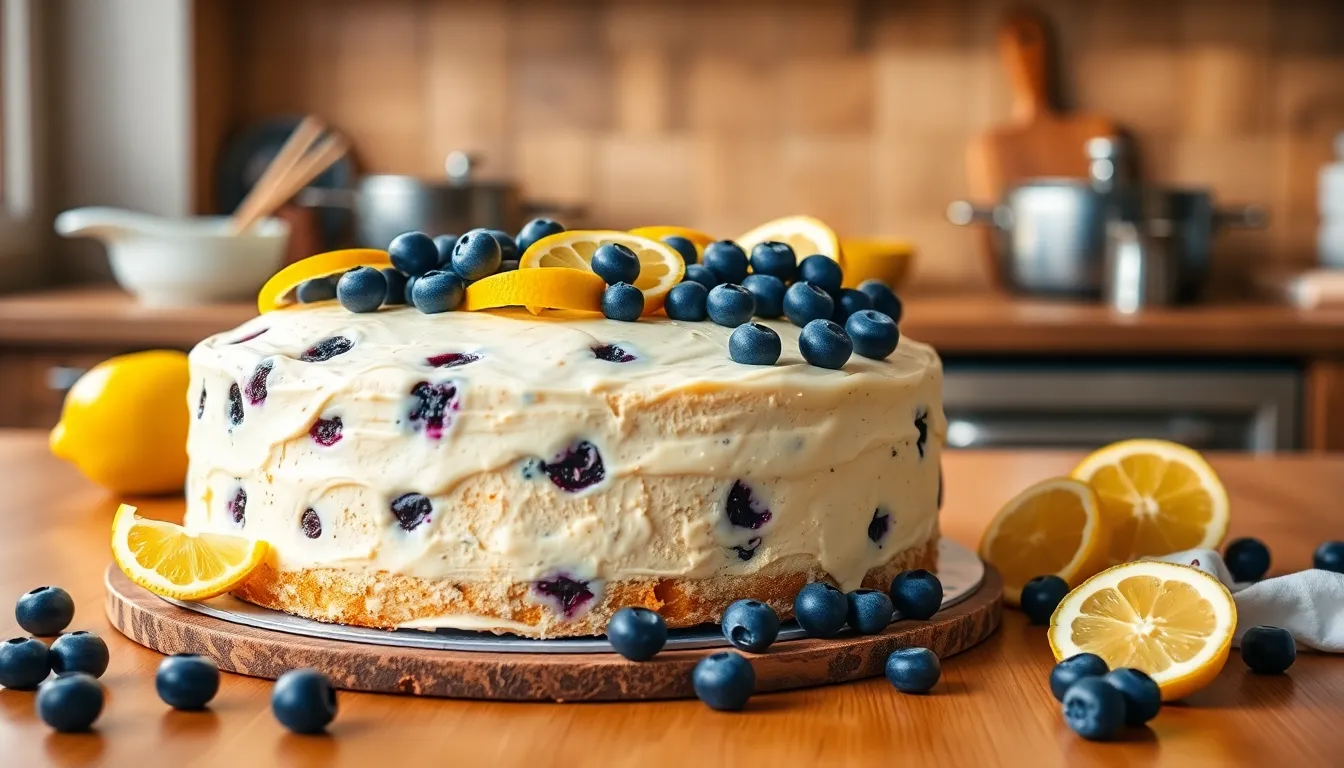
We understand that baking can present unexpected challenges, so we’ve compiled essential answers to help you achieve perfect results every time.
Preventing Blueberries from Sinking
Our most critical tip involves properly preparing your blueberries before adding them to the batter. We coat fresh blueberries with a light dusting of flour, which creates a barrier that helps them stay suspended throughout the cake during baking. This technique prevents the berries from settling at the bottom and ensures even distribution in every slice.
Achieving Optimal Cake Texture
Room temperature ingredients are fundamental to creating a smooth, well-incorporated batter. We recommend removing eggs, butter, and milk from the refrigerator at least 30 minutes before baking. Cold ingredients can cause the batter to curdle or become lumpy, resulting in an uneven texture in the finished cake.
Avoiding Overmixing Issues
Overmixing develops the gluten in flour, which leads to a tough, dense cake rather than the light and fluffy texture we desire. We mix the batter just until the ingredients are combined, stopping as soon as we no longer see streaks of flour. The batter should look slightly lumpy rather than perfectly smooth.
Temperature Control Answers
Oven temperature accuracy affects both baking time and cake structure. We verify our oven temperature with an oven thermometer, as many home ovens run hot or cold. Conventional ovens should be set to 350°F, while convection ovens require 320°F due to their enhanced air circulation.
Doneness Testing Methods
We test for doneness by inserting a toothpick into the center of the cake. The toothpick should come out clean or with just a few moist crumbs attached. Overbaking creates a dry cake, while underbaking results in a gummy texture and potential collapse.
Cooling Process Management
Proper cooling prevents structural issues and ensures clean removal from pans. We cool cakes in their pans for 10 minutes before turning them out onto wire racks. This brief cooling period allows the cake to set while preventing it from breaking apart during removal.
Conclusion
We’ve crafted the perfect recipe that brings together two beloved flavors in one stunning dessert. This lemon blueberry cake delivers everything we look for in a homemade treat – vibrant taste fresh seasonal ingredients and foolproof techniques that guarantee success every time.
Whether you’re planning a weekend brunch or celebrating a special milestone this cake adapts beautifully to any occasion. The detailed instructions storage tips and troubleshooting advice we’ve shared ensure you’ll achieve bakery-quality results right in your own kitchen.
Now it’s time to gather your ingredients preheat that oven and create something truly memorable. Your family and friends will be asking for this recipe long after the last crumb disappears from their plates.
Frequently Asked Questions
How long can I store the lemon blueberry cake?
The cake can be stored at room temperature for up to 2 days if it doesn’t contain cream cheese frosting. With dairy toppings, refrigerate for up to 1 week. Unfrosted cake layers can be frozen for up to 2 months, and individual slices freeze well for convenient serving later.
How do I prevent blueberries from sinking to the bottom of the cake?
Coat fresh blueberries lightly with flour before folding them into the batter. This technique helps the berries stay evenly distributed throughout the cake layers instead of sinking during baking. If using frozen blueberries, add them directly to the batter without thawing.
Can I make this cake ahead of time?
Yes! Bake cake layers up to 2 days in advance and store at room temperature. Unfrosted layers can be wrapped tightly and frozen for up to 1 month. For frosted cakes with dairy content, refrigerate them. Prepare components like lemon glaze separately for best results.
What temperature should I serve the lemon blueberry cake?
Serve the cake at room temperature for the best texture and flavor. This allows the cake’s moist crumb to be fully appreciated and enhances the bright lemon and blueberry flavors. Remove refrigerated cakes 30 minutes before serving to reach optimal temperature.
What are some good toppings or accompaniments for this cake?
Popular options include cream cheese buttercream frosting, a dusting of powdered sugar, fresh whipped cream, or vanilla ice cream. The cake’s tangy-sweet flavor pairs beautifully with creamy accompaniments that complement the lemon and blueberry combination without overwhelming the delicate flavors.
Can I make variations of this recipe?
Absolutely! The recipe works well as a Bundt cake for larger gatherings or as mini cakes for individual servings at parties. Both variations maintain the beloved lemon-blueberry flavors while offering unique presentation options suitable for different occasions and serving sizes.
What’s the most important tip for successful baking?
Use room temperature ingredients for a smooth batter, avoid overmixing to maintain light texture, and ensure accurate oven temperature at 350°F. Properly prepare your pans with grease and parchment paper, and test doneness with a toothpick before removing from the oven.

